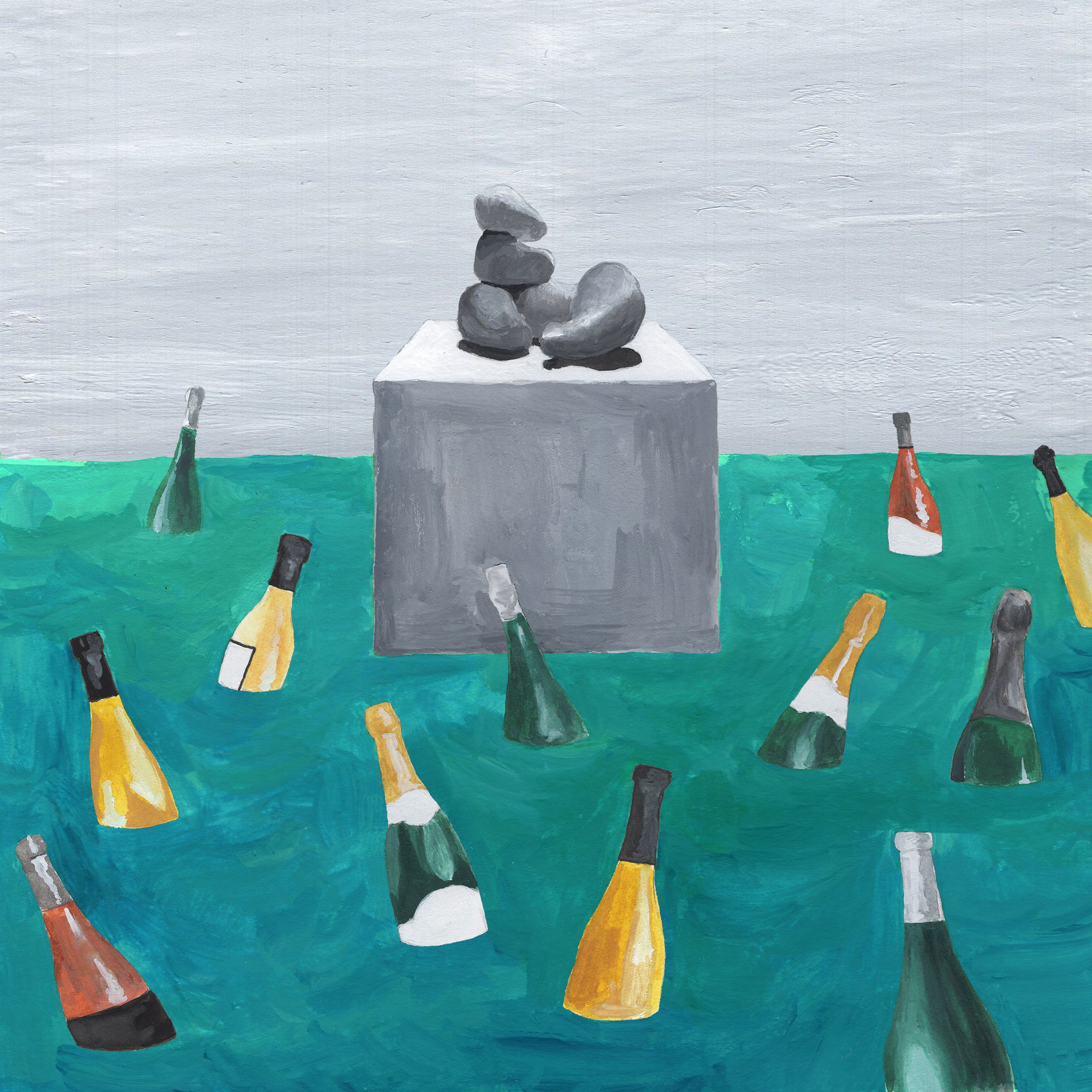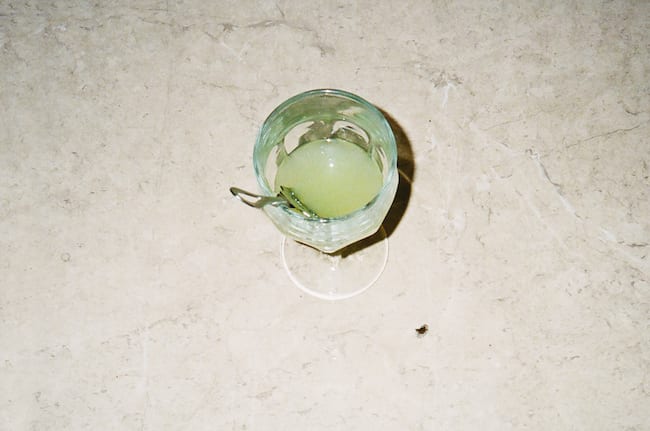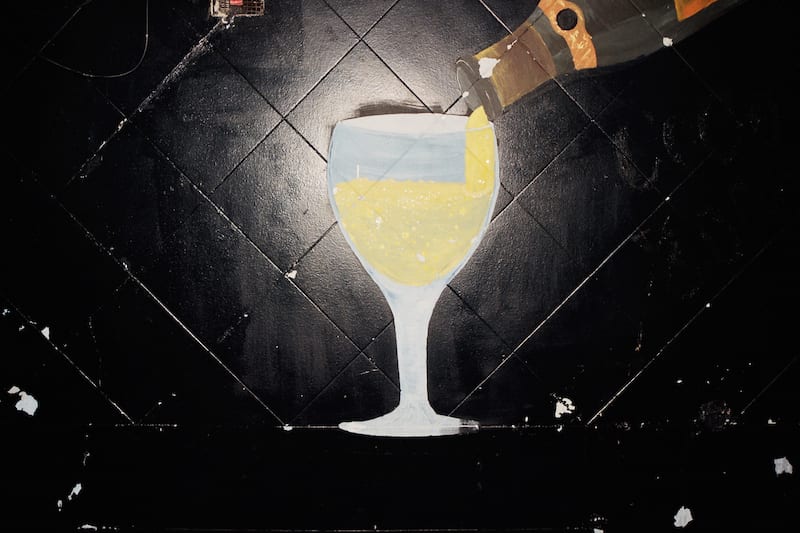
A row of champagne flutes are neatly lined up, poured and ready to serve. For most people, their appearance announces a celebration or special occasion. For the art world, champagne is a common sight, which is not to suggest that the many artists, curators, dealers, writers and collectors are immune to its charms. Undoubtedly, the industry has a lot to celebrate, between exhibition openings and artwork sales—not to mention a relentless calendar of international fairs. That being said, bottles of beer—often thrown carelessly into a large bucket of ice—are another regular fixture at gallery private views, while wine also makes a frequent appearance. For many on the scene, having a drink has become synonymous with the high pressure and high expectations that come with working in the art world. For younger participants, often students or recent MFA graduates, there is a collective understanding that private views offer a space in which to socialize and get drunk—free of charge.
“Every event has to make everyone feel special, and free alcohol is probably the cheapest way to do that,” one freelance art writer reflects, adding that at many events, non-alcoholic options are not readily available: “There’s often nothing to drink except for booze.” I spoke to multiple figures from the art world, most of whom are rarely visible beyond the inner-circle of the industry. While artists and curators will occupy the spotlight more readily, many others—dealers, reporters, PR directors, sales managers and editors—are less recognizable faces, but remain instrumental in the ever-turning tides of the business.
In my many conversations, alcohol emerged as the unspoken glue holding the art world together—an essential social bond for some, and a sticking point for others. Whatever your view, it became clear that drinking forms a tight-knit web that many struggle to disentangle themselves from. As one former sales director at an international blue-chip gallery tells me: “Without alcohol, the art world would not be functioning to the level it is now.”

“If the art world is like high school with cocaine and money, art fairs are prom”
“I was often told when I wasn’t hitting sales targets that I needed to socialize more with my clients, and it was something that I personally found difficult to keep under control,” the sales director recalls. “For me, drinking was a coping mechanism from a lot of high stress. It was my choice to make, but it’s an easy choice when it’s so readily available.” The pressure for hyper-socialization is echoed by a PR director based in New York, who explains: “My job necessitates real relationships with writers and editors in particular, and I attend work-related events most evenings. I always drink at these, unless I’m actually unwell. It comes with rewards, because you do feel that accelerated closeness with someone when you have a drink and ask about people’s real lives.”
It is a familiar story to almost anyone who has attended a party or work event alone; a drink can bolster confidence and ease social anxiety. For the art world, however, it is a vice that comes up again and again. “I joke with art-world friends that if you take people who are naturally nerdy and awkward, they need alcohol to make them more chatty. But it does become a crutch,” a market reporter for The Art Newspaper reflects. “We laugh about how we’re all just socially awkward high-schoolers in a highly monetized environment,” she continues. “I think it has a lot to do with the art-as-lifestyle ethos that has overrun the contemporary art world. It has played into how people want to experience it: they want it to be fun and they want it to be an event. And so, of course, there needs to be parties.”
No occasion presents a better opportunity to party than an art fair, which several people described as spiralling into multi-day binges of alcohol and drugs, in order to fuel high-octane sales and socializing. “The first time I went to Miami Art Basel, I was there alone with the company credit card and it was just the best week of my life,” a communications manager based in New York remembers. “It was like a carnival; a riot. I was drunk all the time. I got a gallery dealer to agree to four issues of advertising, and we did more business in Miami than all the other fairs combined.” As the art market reporter puts it: “If the art world is like high school with cocaine and money, art fairs are prom.” One dealer agrees: “An art fair is a great place to go if you want to get fucked up.”

On the opening day of an fair, it is typical for each exhibiting gallery to have a bottle of champagne at their booth, supplied by the organizers. “You walk around Art Basel or Frieze
and there is champagne on every table. There are the opening drinks, the after-drinks… it’s part of the celebratory nature,” the owner of a London gallery explains. For many, however, the atmosphere is gruelling. “The working hours of an art fair are so long, and the stress is so high, that everyone drinks,” a sales manager reflects. “If your sale goes through, you’re drinking to celebrate. If it doesn’t, you’re drinking to commiserate. One year at Frieze I made the biggest sale of my life and I knew that, whether or not it went through, I was going to get smashed.”
Champagne brands—notably Ruinart and Veuve Cliquot—will often sponsor fairs, stationing ostentatious bars at strategic points around the venue. The association between the two is rooted in an exchange of money and power, as well as a historic link between alcohol and artists. “Champagne companies have really struck gold with the art world. They are using it to present a lifestyle, but this is our day-in-day-out. At an art fair, champagne is basically like water,” the market reporter laughs. Another journalist adds: “I’m always amazed by how people become merciless booze hounds at fairs, including those who have loads of money. At the Frieze Masters preview evening, they serve a couple of trays of champagne and everyone loses their mind; I’m thinking, you probably own a vineyard!”

“I don’t think you should have to say no to ten glasses of champagne a night”
For those struggling with alcohol addiction, however, the prevalence of drink can become a serious issue. “At Frieze Masters I felt like I needed a shield, because on the opening night I was constantly having to say no to offers of alcohol. I was angry because I don’t think you should have to say no to ten glasses of champagne a night,” one recovering alcoholic recalls. Having worked at a high-profile international gallery for over three years, she finally quit in 2018 following a stint in rehab. “I saw people relapsing at Frieze, which really disturbed me. For some people it’s Christmas that is really challenging, but for me it was the fair,” she adds. “You’re so exposed to it, and no one cares. No one. There are a lot of young people in the art world, and there’s no responsibility. Alcohol kills people.”
Alcohol may kill people, but drinks sponsors remain big business. A London gallerist recalls Becks-sponsored private views in the late 1990s and early 2000s, when galleries would receive crates of beer to serve to guests. “I often wonder whether they gave beer to private views because they were popular, or the openings were popular because there was free beer. I used them as a social space, as a place to drink for free,” he muses. There was even the Beck’s Futures art prize, established in partnership with London’s Institute of Contemporary Arts
, which ran from 2000 to 2006. The Absolut Vodka Art Award, founded in 2009, still gives cash prizes to artists and art writers annually, as well as sponsoring pop-up “art bars”.

The relationship between alcohol and artists is a storied and well-trodden one, and all the more intriguing for being out in the open. “It’s ingrained historically as part of the myth of the artist as the outsider,” a curator argues. “We all know the stories of alcoholic excess: absinthe in the 1920s, Jackson Pollock, all the way up to the YBAs—it’s part of the life.” This is reflected in the interests of gallerists themselves. Gavin Brown opened a bar named Passer By in front of his Chelsea gallery space in 1997 (it closed in 2003 when the gallery moved to Harlem). Hauser and Wirth’s Chelsea space, just a few streets from Brown’s original watering hole, still houses a bar.
The allure of the bohemian lifestyle is pervasive, and one that came up repeatedly in my conversations. “Everyone wants to be like the artist, and maybe people are just taking cues from that,” a PR and events director suggests. The pressure on artists to live up to their reputation can be risky, however. A high-profile painter in their late thirties argues, “I do think it’s dangerous, the romancing of alcohol and artists, but it’s part and parcel, and it’s the one thing that drives the hedonism as well.” A British gallerist agrees: “You can see the artist and say, ‘Oh they’re so flamboyant, they’re so fabulous,’ but in fact there are often underlying mental health problems that have been exacerbated by drinking. I’ve seen it a lot.”
But do artists really have a different, more troubled, relationship with alcohol when compared to others in the industry? “I don’t believe so,” the reporter argues. “Frankly, as I cover the art market a lot, I think that business types are actually just as bad, if not worse. I think it’s that whole American corporate greed ethos that comes out to play. You don’t expect it because you work in the arts, and you’re not necessarily trained or prepared to deal with it.” Another journalist agrees: “I’ve met artists who drink too much and take too many drugs; I’ve met curators and gallerists who do the same; I’ve met shipping people who get totally wrecked. It’s not just the artists.”
“I often wonder whether they gave beer to private views because they were popular, or the openings were popular because there was free beer”

Even as clean-living and abstention have been cited as the buzzwords of the millennial generation, the art world’s relationship with the bottle shows few signs of shifting. Some New York galleries no longer serve alcohol at openings, while in LA—the mecca of teetotalism—these openings are staged on sedate Saturday afternoons. For most people in the industry, however, drink remains a staple of the job, which comes with its own set of positives as well as negatives. “While there are many problematic elements, it’s important to remember that there have been good times,” the market reporter reflects. “If I don’t have permanent liver damage, I will look back on my time in the art world very fondly.” The recovering addict finds their peace elsewhere, ending on a cautionary, heartfelt note: “Ultimately, I know that I’m not the first or the last person to work in the art world to go to rehab,” she concludes. “My experience is that I felt very isolated. In order for things to get better, they need to be more spoken about.”
Photographs by Lorena Lohr
Top illustration by Antonia Stringer





